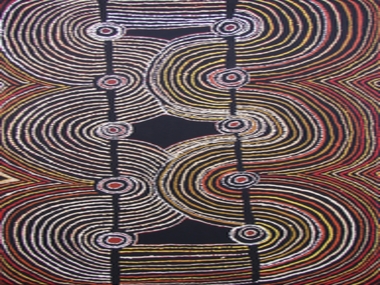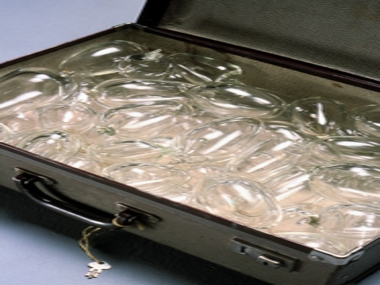TANDANYA AND SA ABORIGINAL ART HIT 20

Hector Tjupuru Burton's ' Anumara tjukurpa' 2009 Synthetic polymer paint on linen The Marshall Collection, Adelaide © The artist and Tjala Arts
Posted by Jeremy Eccles | 02.12.09
Gallery: Tandanya – National Aboriginal Cultural Institute
Dates:
10.10.09
: 06.12.09
It doesn't often hit the headlines, but the Tandanya National Aboriginal Cultural Institute (to give its proper name) in Adelaide has been plugging away at the job of showing the world through Aboriginal eyes for 20 years now.
I assume it runs on the smell of an oily rag. But Tandanya's complementary role in Adelaide with the SA Museum of showing and linking the past and the present in indigenous culture is a vital one – especially in a State that used to incorporate the NT, and which still stretches from the big city, through some key patches of on-going indigenous life like The Coorong and the Riverland, to the remote deserts of the APY Lands (Anangu/Pitjanjatjara/Yankunytjatjara) of South Australia's north where traditional life still flourishes.
So to find them splashing out on a catalogue with innumerable pictures and serious articles to celebrate their own birthday and the “mind-boggling diversity” of Aboriginal art across the State (in the words of curator Fulvia Mantelli) is a joy to share. Sadly the actual exhibition at Tandanya runs only until the end of this week – Sunday 6th December.
But 47 artists and more than 80 of their works are featured – several being accorded fascinating variations in their work from career beginning to end. There are the already famous – pioneering painter in the fault-line between remote and urban Australia. And then there are almost unknown local heroes – Kenneth Ross McKenzie revealing the Flinders Ranges and Beaver Lennon from Ceduna on the Great Australian Bite.
Such a spread inevitably pushes the boundaries on a range of local issues like the horrors of Maralinga in Jonathan Kunmanara Brown's 'Poison Country' – where the Tingari initiation ceremonies no longer happen; Nura Rupert's 'Spooky Spirits' out at Ernabella; and Agnes Love's joyous 'Indigenous Drag Queens' in the colourful heart of Adelaide. Mantelli somehow discerns synchronicities between these disparate elements – between the urban and the remote, the cultural knowledge and the popular culture. Others may only see a wondrous gathering of indigenous spirit from, as far away as the Palawa of Tasmania, the Noongar of WA, and both the Jawoyn and Gurindji of the NT. Local Ngarrindjeri, Kokotha, Pitjanjatjara and Adnymathanha are naturally predominant. But why none of Adelaide's Kaurna?
One intriguing discovery in the catalogue is that the earliest works almost all come from the city – 1989 was obviously a fruitful time for indigenous activism in Adelaide. Out in the desert, though, the APY people resisted giving up their culture to the wider world until really quite recently. But artists with the depths of traditional knowledge that the 70-something Hector Tjupuru Burton from Amata have are filling their lives and our wall-spaces with some of the greatest Aboriginal art currently available.
URL: www.tandanya.com.au
Share this:
»  del.icio.us
»
del.icio.us
»  Digg it
»
Digg it
»  reddit
»
reddit
»  Google
»
Google
»  StumbleUpon
»
StumbleUpon
»  Technorati
»
Technorati
»  Facebook
Facebook
Contact Details
Gallery: Tandanya – National Aboriginal Cultural Institute
Email: tandanya@tandanya.com.au
Telephone: +61 8 8224 3200
Address: 253 Grenfell Street Adelaide Adelaide 5000 SA
Gallery: Tandanya – National Aboriginal Cultural Institute
Email: tandanya@tandanya.com.au
Telephone: +61 8 8224 3200
Address: 253 Grenfell Street Adelaide Adelaide 5000 SA

Yhonnie Scarce 'The day we went away' 2004 Blown glass, found suitcase, glass. Courtesy the artist
Where is the exhibition?
Further Research
Gallery: Tandanya – National Aboriginal Cultural Institute
Artists: Agnes Love | Beaver Lennon | Hector Tjupuru Burton | Ian Abdullah | Jonathan Kunmanara Brown | Kenneth Ross McKenzie | Nura Rupert | Trevor Nickolls | Yvonne Koolmatrie
News Tags: Adelaide | APY Lands | South Australia | Tandanya
News Categories: Australia
Exhibition Archive
- 10.10.17 | TARNANTHI 2017
- 11.08.17 | Natsiaas 2017
- 20.07.17 | APY ART DOMINATES THE WYNNE
- 17.07.17 | Anangu Artist Wins $100,000 Prize
- 14.07.17 | The End of AAMU
- 11.07.17 | ART ACROSS THE COUNTRY
- 11.07.17 | TARNANTHI IN OCTOBER
- 05.07.17 | TJUNGUṈUTJA - from having come together
- 13.06.17 | Ghost-Nets Straddle the World
- 07.06.17 | Grayson Perry Going Indigenous?
- 05.06.17 | Barks Bigger than Ben Hur
- 27.05.17 | NGA QUINQUENNIAL 2017
- 21.05.17 | Blak Douglas Finds Home at the NGA
- 21.05.17 | BRIAN ROBINSON WINS HAZELHURST WOP
- 18.05.17 | PARRTJIMA 2.0
Advertising

